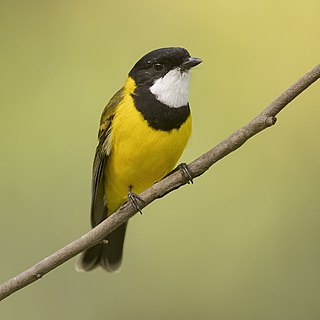
The Australian golden whistler or golden whistler, is a species of bird found in forest, woodland, mallee, mangrove and scrub in Australia. Most populations are resident, but some in south-eastern Australia migrate north during the winter. Its taxonomy is highly complex and remains a matter of dispute, with some authorities including as many as 59 subspecies of the golden whistler, while others treat several of these as separate species. This bird is also known as White-Throated Thickhead in older books.

Adolf Bernhard Meyer was a German anthropologist, ornithologist, entomologist, and herpetologist. He served for nearly thirty years as director of the Königlich Zoologisches und Anthropologisch-Ethnographisches Museum in Dresden. He worked on comparative anatomy and appreciated the ideas of evolution, and influenced many German scientists by translating into German the 1858 papers by Darwin and Wallace which first proposed evolution by natural selection. Influenced by the writings of Wallace with whom he interacted, he travelled to Southeast Asia, and collected specimens and recorded his observations from the region.

Pachycephala is a genus of birds native to Oceania and Southeast Asia. They are commonly known as typical whistlers. Older guidebooks may refer to them as thickheads, a literal translation of the generic name, which is derived from the Ancient Greek terms pachys "thick" + kephale "head". This lineage originated in Australo-Papua and later colonized the Indonesian and Philippine archipelagos to the west and the Pacific archipelagos to the east.

Eopsaltria is a genus of small forest passerines known in Australia as the yellow robins. They belong to the Australasian robin family Petroicidae. The name is derived from the Ancient Greek for "dawn singer/song" because of their dawn chorus. They are inquisitive and bold birds, and have been reported perching on the shoulders or boots of people in the bush. Open eucalyptus woodlands are their preferred habitat. The ornithologist John Gould likened the behaviour and mannerisms of the eastern and western yellow robin to those of the European robin. The name "yellow robin" itself was applied to the eastern yellow robin by the early settlers of New South Wales.

The canary flyrobin, also known as the Papuan flycatcher, canary robin, canary flycatcher, or montane flycatcher, is a species of bird in the family Petroicidae. It is found in New Guinea. Its natural habitat is subtropical or tropical moist montane forests with elevations from 1,100–3,500 m (3,609–11,483 ft). Currently, its population is believed to be stable.

The Melanesian whistler or Vanuatu whistler, is a species of passerine bird in the whistler family Pachycephalidae. It is found on the Loyalty Islands, Vanuatu, and Vanikoro in the far south-eastern Solomons.
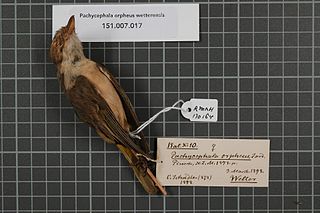
The fawn-breasted whistler is a species of bird in the family Pachycephalidae. It is found on the islands of Timor and Wetar. Its natural habitats are subtropical or tropical moist lowland forests and subtropical or tropical mangrove forests.
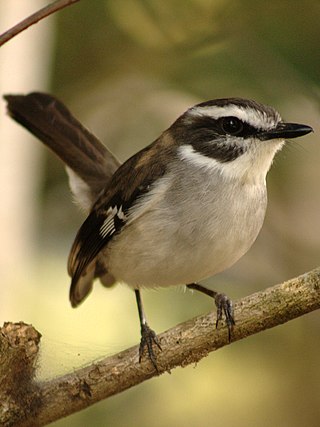
Poecilodryas is a genus of passerine birds in the Australasian robin family Petroicidae.
The white-throated Fiji whistler is a species of bird in the family Pachycephalidae, endemic to islands in southern Fiji. It was formerly considered to be conspecific with the yellow-throated Fiji whistler. Before the split the combined species were known as the "Fiji whistler".

The rusty-breasted whistler, also known as the fulvous-tinted whistler, is a species of bird in the family Pachycephalidae. It is endemic to Indonesia, where it ranges from Java east to Alor and north to the Selayar Islands.

The yellow-throated whistler or Banda Sea whistler, is a species of bird in the family Pachycephalidae. It is endemic to central and south-eastern Wallacea, where it ranges from Timor east to the Tanimbars and north to Seram and Banggai. The oriole whistler is sometimes alternatively called the yellow-throated whistler, leading to confusion between both species.
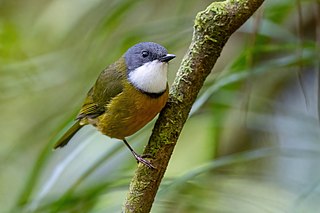
The New Caledonian whistler is a species of bird in the family Pachycephalidae. It is endemic to New Caledonia.
The Vanikoro whistler is a passerine bird in the family Pachycephalidae, which is endemic to the southeast Santa Cruz Islands of the Solomon Islands group. The Nendo whistler and Utupua whistler were formerly treated as subspecies. Before the split the combined species were known by the English name "Temotu whistler".

Lalage is a genus of passerine birds belonging to the cuckooshrike family Campephagidae, many of which are commonly known as trillers. There are about 20 species which occur in southern Asia and Australasia with a number of species on Pacific islands. They feed mainly on insects and fruit. They build a neat cup-shaped nest high in a tree.
The Selayar whistler (Pachycephala teysmanni is a species of bird in the family Pachycephalidae. It is endemic to the small island of Selayar, which lies to the south of Sulawesi in Indonesia. It was formerly considered to be a subspecies of the rusty-breasted whistler.
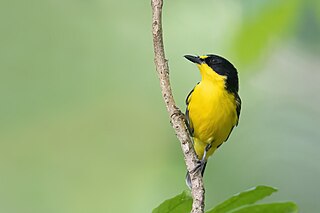
The yellow-throated Fiji whistler is a species of passerine bird in the family Pachycephalidae, endemic to central Fiji. It was formerly considered to be conspecific with the white-throated Fiji whistler. Before the split the combined species were known as the "Fiji whistler".
The Nendo whistler is a passerine bird in the family Pachycephalidae. It is endemic to Nendö, as well as the Reef and Duff islands in the Santa Cruz Islands of the western Pacific Ocean. It was formerly treated as a subspecies of the Vanikoro whistler. Before the split the combined species were known by the English name "Temotu whistler".
The Utupua whistler is a passerine bird in the family Pachycephalidae that is endemic to the island of Utupua in the Santa Cruz Islands of the western Pacific Ocean. It was formerly treated as a subspecies of the Vanikoro whistler. Prior to the split the combined species were known by the English name "Temotu whistler".
The Sangihe cicadabird is a passerine bird in the family Campephagidae that is endemic to the island of Sangir, also written as "Sangihe", and the Talaud Islands. These islands lie northeast of Sulawesi in Indonesia. The species was formerly considered to be conspecific with the Sulawesi cicadabird.
The Timor cicadabird is a passerine bird in the family Campephagidae that is found on the islands of Lembata, Alor and Timor in Indonesia. The species was formerly considered to be conspecific with the common cicadabird, now renamed the Sahul cicadabird.












